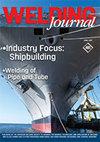Capacitor Discharge Spot Welding of Aluminum, Part 1: Weldability Assessments
IF 1.4
3区 材料科学
Q2 METALLURGY & METALLURGICAL ENGINEERING
引用次数: 1
Abstract
A key aspect of integrating automotive sheet into automotive production are the costs associated with joining. While the majority of sheet steel assembly is done with resistance spot welding, that has not readily translated to aluminum. Resistance spot welding of aluminum sheet is challenged by high current demand as well as reduced electrode life. In the latter case, direct current (DC) power supplied by state-of-the-art systems has exacerbated the problem. Recently, technology employing capacitor discharge (CD) welding in conjunction with polarity switching has been developed. This work is a first effort in examining the response of resistance spot welding on aluminum sheet to polarity-switching CD power. In this paper, the current range response between medium-frequency DC (MFDC) and polarity-switching CD was investigated. It was found that polarity-switching CD welding offered improved current ranges over MFDC. In addition, replicate mechanical testing cross-tension results were similar, but tensile shear strengths improved nominally 20–25%. Finally, some limited tests were done to assess the suitability of CD resistance spot welding in the presence of an adhesive. Current range tests with and without a prepulse were done, and both showed excellent weldability.铝电容器放电点焊,第1部分:可焊性评定
将汽车板材集成到汽车生产中的一个关键方面是与连接相关的成本。虽然大多数钢板组装都是用电阻点焊完成的,但这并不容易转化为铝。铝板的电阻点焊受到高电流需求和电极寿命缩短的挑战。在后一种情况下,由最先进的系统提供的直流电加剧了问题。最近,已经开发出将电容器放电(CD)焊接与极性切换相结合的技术。这项工作是首次研究铝板电阻点焊对极性切换CD电源的响应。本文研究了中频直流(MFDC)和极性切换CD之间的电流范围响应。发现极性切换CD焊接比MFDC提供了改进的电流范围。此外,重复的机械测试交叉拉伸结果相似,但拉伸剪切强度名义上提高了20-25%。最后,进行了一些有限的测试,以评估在粘合剂存在的情况下CD电阻点焊的适用性。进行了有预脉冲和无预脉冲的电流范围测试,两者都显示出良好的可焊性。
本文章由计算机程序翻译,如有差异,请以英文原文为准。
求助全文
约1分钟内获得全文
求助全文
来源期刊

Welding Journal
工程技术-冶金工程
CiteScore
3.00
自引率
0.00%
发文量
23
审稿时长
3 months
期刊介绍:
The Welding Journal has been published continually since 1922 — an unmatched link to all issues and advancements concerning metal fabrication and construction.
Each month the Welding Journal delivers news of the welding and metal fabricating industry. Stay informed on the latest products, trends, technology and events via in-depth articles, full-color photos and illustrations, and timely, cost-saving advice. Also featured are articles and supplements on related activities, such as testing and inspection, maintenance and repair, design, training, personal safety, and brazing and soldering.
 求助内容:
求助内容: 应助结果提醒方式:
应助结果提醒方式:


